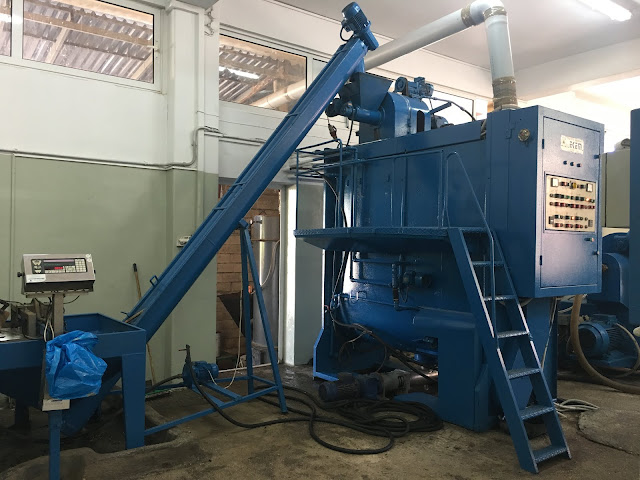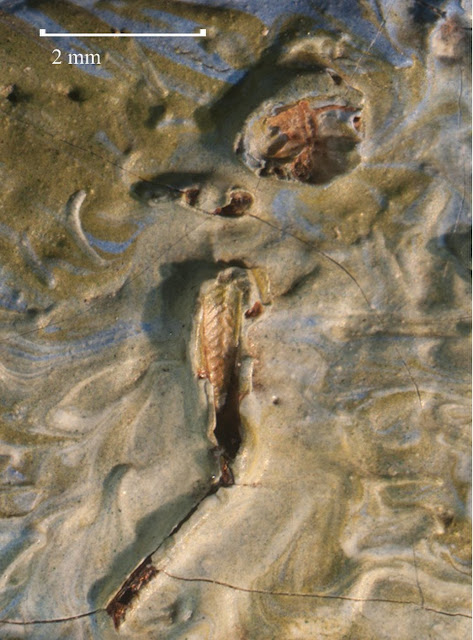The Olive Trees - Vincent Van Gogh 1889
Olive trees at Foki beach near Fiskardo
Olive trees in January 2017, enduring the snow that they're just not used to!
The wood and products of olive wood tend to be expensive as the tree itself is relatively small and slow growing. It costs, in general, 100 Euros for 1 ton of the seasoned olive wood and this would last us approximately 2 months depending obviously on the weather and how often we use the woodburner in the winter. It's important that the wood is "seasoned" (dried) if it's to be used in a wood burner as moisture affects how it burns.
Kefalonia has numerous olive groves, and olive oil is a major component of Kefalonia's economy. There are over 1 million olive trees on the island. Before the Ionian earthquake of 1953 which devastated Kefalonia, there were 200 oil presses operating on the island. Today there are about 13.
Remains of an olive press from the Ionian earthquake in Grizata
There are 2 main varieties of olives on Kefalonia - Koroneiki and Theiako. These varieties give Kefalonian olive oil a green tone, rich greasy touch and low acidity.
We use olive oil for cooking on a daily basis (Kefalonian of course!) ..........but how is olive oil made?
I have to admit to not knowing the process of olive oil production and was curious to find out, so with it being the season to harvest olives, I decided to start at the beginning with exactly that - harvesting.
Olive trees will usually have a mixture of purple and green olives, the only difference being is that they are at a different stage of maturity - green olives are unripe and the purple olives are ripe but they are harvested together.
How do you get the olives off the trees? Here on Kefalonia it's by hand. Netting is placed around the tree trunk, branches are sawn off (good for the tree for future production of olives) and the olives picked off these branches by hand or with a small hand rake. Other tools used include an oliviera - a long handled electric harvester stick which has large tongs that spin around quickly, and an olive gathering machine. No large scale industrial type mechanisation though.
The olives are bagged and then sent to an olive press. Oxidisation of the olives begins immediately after harvesting so it's best that pressing is done within 24 hours otherwise a lower quality oil is obtained.
Next to find an olive press on the island. Can't be hard......but where are they?
One of many olive groves near us on Kefalonia
Olive trees will usually have a mixture of purple and green olives, the only difference being is that they are at a different stage of maturity - green olives are unripe and the purple olives are ripe but they are harvested together.
Mixture of olives
How do you get the olives off the trees? Here on Kefalonia it's by hand. Netting is placed around the tree trunk, branches are sawn off (good for the tree for future production of olives) and the olives picked off these branches by hand or with a small hand rake. Other tools used include an oliviera - a long handled electric harvester stick which has large tongs that spin around quickly, and an olive gathering machine. No large scale industrial type mechanisation though.
Placing the netting
Small hand rake which combs off the olives
Olive gathering machine
Olive gathering machine
Collection of olives together with leaves and twigs
The olives are bagged and then sent to an olive press. Oxidisation of the olives begins immediately after harvesting so it's best that pressing is done within 24 hours otherwise a lower quality oil is obtained.
Bags of olives awaiting transportation to the olive press
Next to find an olive press on the island. Can't be hard......but where are they?
Friends told us about a local one so we decided to pay it a visit. It's just outside of Xaliotata not far from Sami, literally about 1 mile away from where we live. We've been living here for 19 months now and never seen it, but of course we wouldn't as it's hidden inside the grounds of a cement factory. ..... of course.....where else would you find an olive press!
We passed the large blue sign (below) a few times but not knowing what it meant, we ended up going down dirt tracks in search of the olive press until we came upon some locals with a truck of olive oil. They showed us where it was and yes it was where the sign was. At least I now know the Greek for olive oil!
We passed the large blue sign (below) a few times but not knowing what it meant, we ended up going down dirt tracks in search of the olive press until we came upon some locals with a truck of olive oil. They showed us where it was and yes it was where the sign was. At least I now know the Greek for olive oil!
Location of olive oil press inside the cement factory.
Greek for "Olive Oil"

We called in, on the off chance that the press would be working and it was.The facility here uses the modern method of olive pressing - centrifugation - as oppose to the traditional method of millstones. It's also cold pressed which means that the temperature cannot exceed 27 degrees centigrade giving a higher quality olive oil.
As we arrived so did a truck with bags of freshly picked olives. The manager of the facility was really good and allowed me to take photos of the whole process. He even showed us around and explained what was happening at each of the stages without us even asking.
It's all about batch processing - Each customer batch must be kept separate and identifiable with the owner. Customers pull up with their own olives which are then processed. - It's a continuous process - the machinery only stopping for cleaning and maintenance purposes so customers need to know that they are taking home only their own olive oil!
As we arrived so did a truck with bags of freshly picked olives. The manager of the facility was really good and allowed me to take photos of the whole process. He even showed us around and explained what was happening at each of the stages without us even asking.
It's all about batch processing - Each customer batch must be kept separate and identifiable with the owner. Customers pull up with their own olives which are then processed. - It's a continuous process - the machinery only stopping for cleaning and maintenance purposes so customers need to know that they are taking home only their own olive oil!
Truck arriving laden with olives reversing into the facility.

The facility
The olives are emptied into a large hopper and a conveyor belt takes them, in smaller quantities, up to be washed.
Emptying the olives into the hopper
The olives are then washed in water to remove traces of soil and other contaminants. Leaves, twigs and other bits and pieces are filtered out at this stage so all that remains is the olives.
The olives being washed and stripped of leaves
As the clean olives drop into the hopper they are weighed. This is important as the amount you pay to have your olives pressed is determined by this cleaned raw product weight and not the amount of olive oil produced.
This batch weighed in at 227kg
Nothing goes to waste though. The leaves and twigs are collected and go back into the fields as fertilizer.
No waste here!
The olives are made into a paste by metal crushers.
Next the olive paste is malaxed (slowly churned) for up to an hour. This allows the small olive droplets to combine. The temperature here is critical as it cannot exceed 27 degrees centigrade in order for it to be called "Cold Pressed". The operator of the facility lifted up the grate covers on the machine to allow us to smell the aroma. Amazing!
The silver machine malaxes the olives.
The paste is then pumped into an industrial decanter (centrifuge) where water is added to facilitate the extraction process. The paste becomes separated into waste solids, water and olive oil.
Industrial decanter

and...... the end result - after a 2 hour process from start to finish.
Olive oil
All that remains is to pump the olive oil into your own containers. You can weigh the amount of olive oil that you have produced here too.
The waste solids (kernels) are collected and used as fuel for the boiler in the facility. Apparently it can be used in wood burners too and also as fertiliser on the fields. Again - nothing wasted here!


On the left of the photo you can see a collection of old mill stones that were once used.
Off home now

Millstones

As I started with a Van Gogh - so I'll finish with one......
Olive Orchard - Van Gogh - June 1889
The partial remains of a tiny grasshopper were discovered embedded in the paint in this painting in November 2017 when the canvas was viewed under a surgical microscope. It has remained undetected for 128 years!
I just can't get away from microscopes!




























